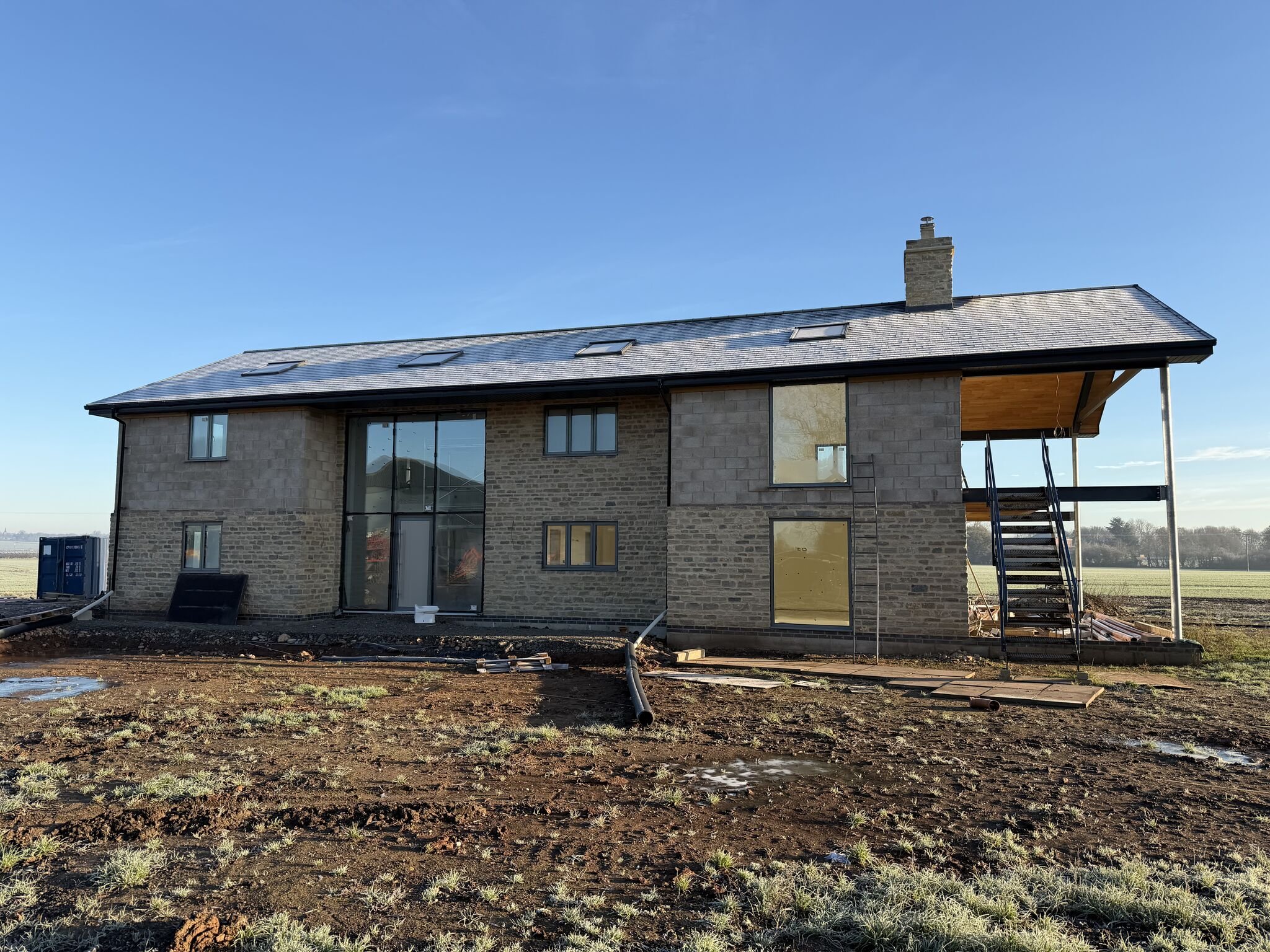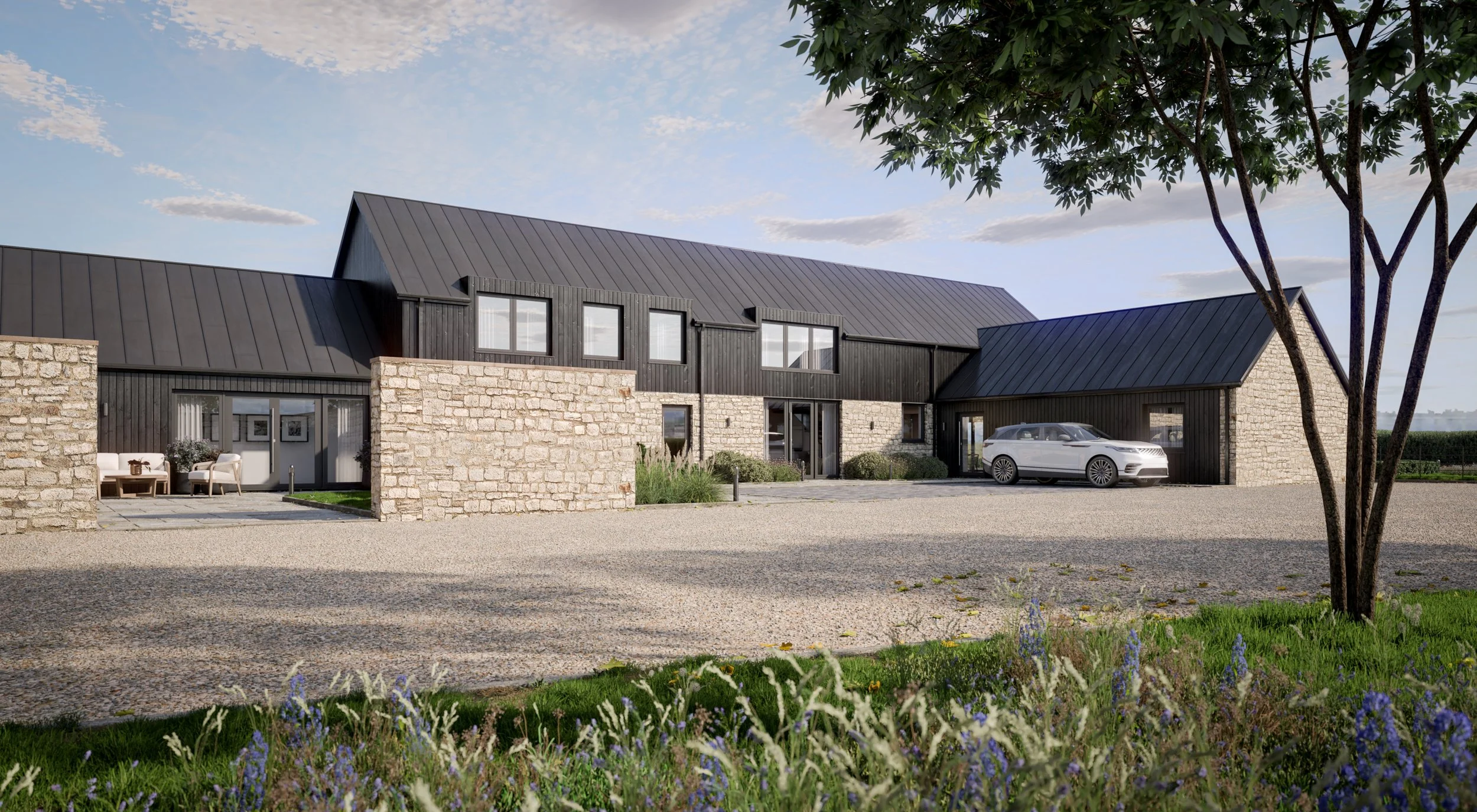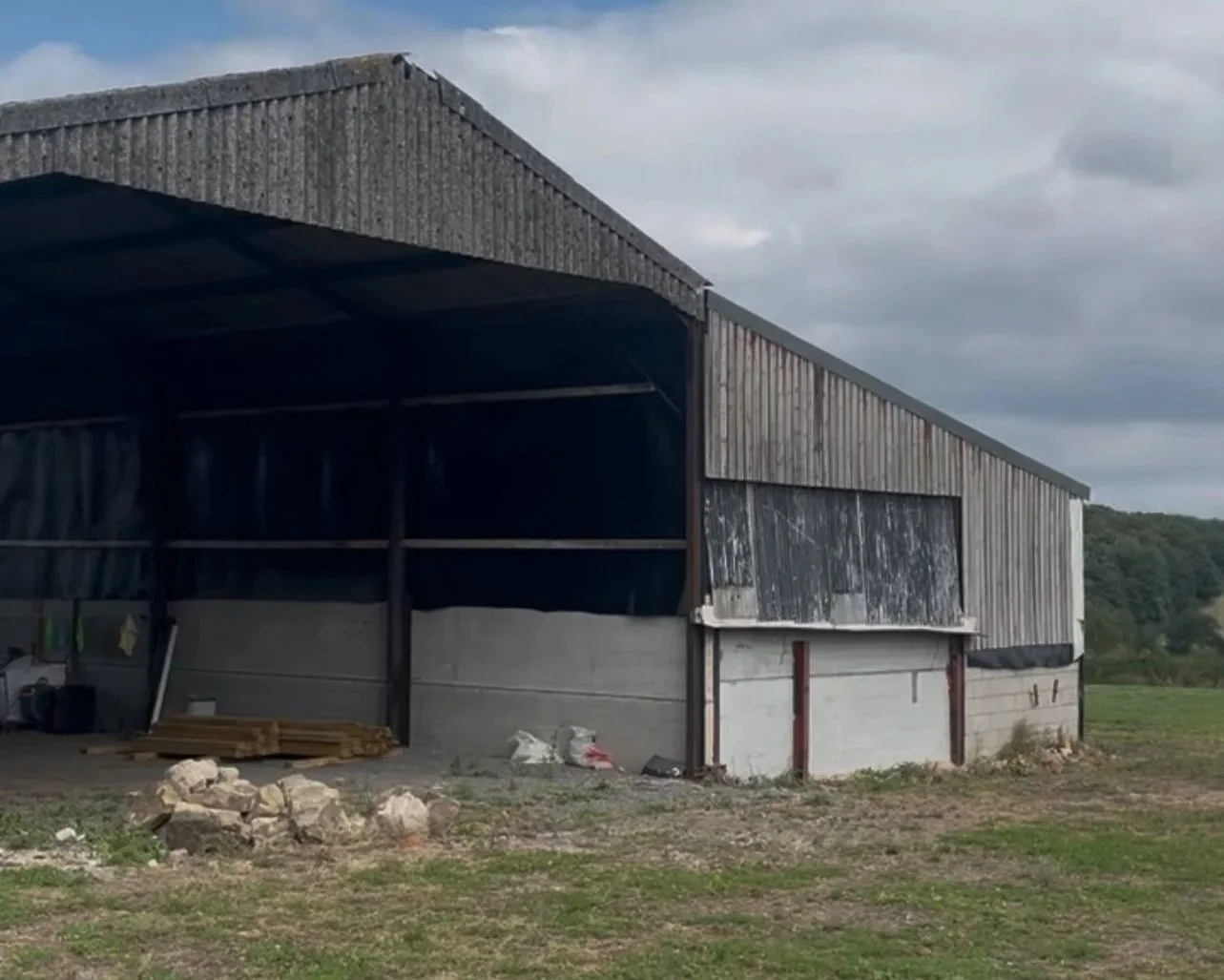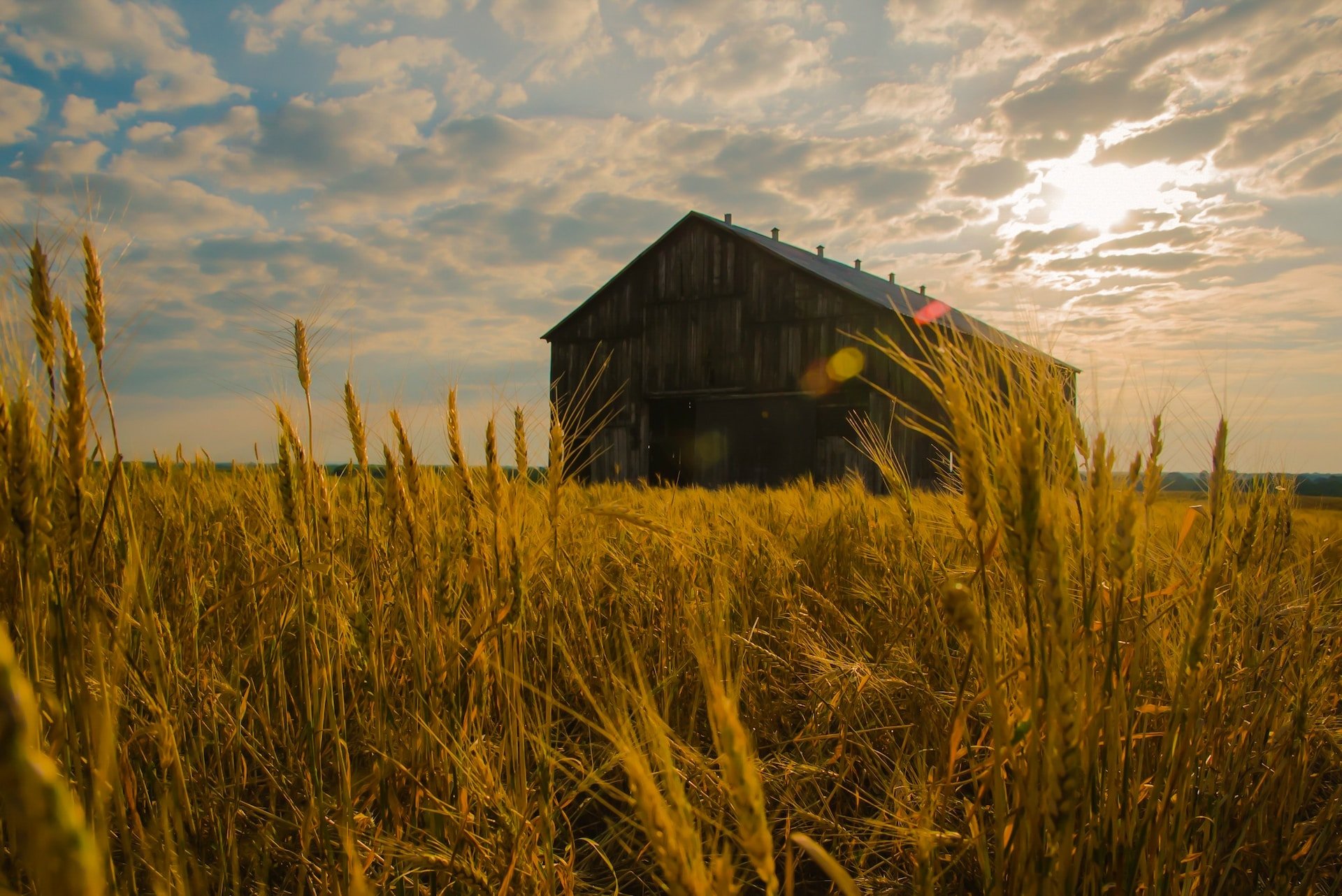From Vision to Value: Turning Ideas into Projects with Purpose
TUK Rural helps landowners, homeowners, and developers turn early ideas into successful rural planning and development projects. By combining feasibility insight, purposeful design, and integrated architecture and planning expertise, we guide you from first concept to approved, buildable plans that deliver long-term value.
by Phil Tuckwell, Director
Every successful project starts with an idea. But in rural development, turning that initial spark of inspiration into something tangible – and financially viable – takes more than just creativity. It takes understanding: of land, of place, of policy, and of how to navigate the journey from vision to value.
At TUK Rural, that’s exactly what we’re here to do. We help landowners, homeowners, and developers to translate ambition into action, creating projects that not only look good on paper but deliver lasting impact in the real world.
A site visit in North Warwickshire, undertaking a build-stage inspection for a four-bedroom barn-style new home on a working farm
Bringing clarity to the early stages
Many of the best projects begin as conversations. Sometimes they’re around a kitchen table, sometimes on the edge of a field, sometimes they’re with us on the end of a phone or a FaceTime call. Regardless of the method, our role is to listen carefully, ask the right questions, and help define what’s really possible within the planning and policy framework.
By exploring feasibility early on, we can identify opportunities that others might miss, reduce your risk, and ensure that your project’s foundations are solid before a single drawing is produced. It’s about setting a clear direction that aligns vision with value from day one.
Design is all about adding purpose and function.
Designing with purpose
Good design is never about aesthetics alone. For us, design is a means of adding purpose and function: creating buildings and spaces that serve both people and place. Whether we’re extending a rural home, converting an agricultural building, or planning a new development, our approach is grounded in respect for the surrounding landscape and local character.
We believe the best rural projects enhance their setting, working with materials, form, and proportion to create something that feels both timeless and practical.
It helps that this is also the best way to make sure your project isn’t hampered by unnecessary planning delays.
Delivering value beyond the drawings
Value comes in many forms. Of course we will help you to consider financial returns, but we will also look at your project’s long-term usability, sustainability, and community benefit. Our integrated architecture and planning teams ensure that each project balances these considerations, turning complex ideas into approved, buildable designs.
It’s a process that requires technical expertise, collaboration, and persistence, but it’s the way we can be sure we’ll take the potential of your project and turn it into plans, progress and ultimately a reality.
Nothing beats the satisfaction of seeing a project brought to life.
From first sketch to finished project
No two projects are the same, and that’s what makes our work so rewarding. Whether you’re considering a small extension, a barn conversion, or a multi-plot development, we’ll guide you through every step. From initial concept and feasibility through to planning, design, and delivery, we can be with you all the way.
If you’ve got an idea and want to explore its potential, our team would love to hear from you. Together, we’ll help you turn your vision into something with real value and purpose.
Contact us today to start the journey!
The Benefits of Rural Diversification: Making the Most of Existing Buildings
For many landowners, farm buildings and rural properties often sit unused or underutilised. Yet with the right vision and planning, those same buildings can be transformed into valuable assets that support your family, your business and your community. Rural diversification is all about making the most of what you already have, and it can open the door to new opportunities, income streams, and long-term sustainability.
For many landowners, farm buildings and rural properties often sit unused or underutilised. Yet with the right vision and planning, those same buildings can be transformed into valuable assets that support your family, your business and your community.
Rural diversification is all about making the most of what you already have, and it can open the door to new opportunities, income streams, and long-term sustainability.
What is rural diversification?
In simple terms, rural diversification means branching out from traditional farming or land use and exploring new ways to generate value. For some, that might mean converting barns into homes; for others, it could involve repurposing agricultural buildings for business use, tourism, or community projects.
Why focus on existing buildings?
Planning policy is generally more supportive of reusing existing buildings than building from scratch in open countryside. Local authorities often prefer to see redundant or disused buildings brought back into use, whether that’s through Class Q barn conversions or other change-of-use applications. This makes existing buildings the ideal starting point for most diversification projects.
The benefits include:
Reduced planning risk – Councils are more likely to look favourably on projects that reuse and improve what’s already there.
Lower costs – Adapting a building is often more cost-effective than a new build, particularly when services and access are already in place.
Character and charm – Older barns and rural buildings carry unique features that can add value and appeal, especially in residential or tourism-led projects.
Environmental sustainability – Reuse reduces the need for new materials and limits the impact on the surrounding landscape.
Popular diversification opportunities
Every site is different, but some common ways landowners are making better use of their existing buildings include:
Barn conversions into homes – whether under Class Q or full planning applications.
Holiday lets and tourism accommodation – tapping into the demand for countryside escapes.
Commercial units – workshops, storage, or office space for local businesses.
Community uses – from village halls to childcare facilities.
Making it work for you
The key to successful diversification is balancing your ambition with planning policy and market demand. That means asking questions such as:
What is the building’s current condition and what will it take to bring it up to standard?
Is there proven demand in your local area for residential, tourism, or commercial use?
How do planning policies apply to your specific building?
At TUK Rural, we specialise in helping landowners unlock the potential of their existing buildings. From exploring permitted development routes to preparing full planning applications, we work with you to make diversification both realistic and rewarding.
Rural diversification isn’t about abandoning farming or tradition: it’s about making smart use of your assets to secure your future. If you’ve got unused or underused buildings, there’s every chance they could be the foundation of your next opportunity.
Facing the Planning Committee – A Personal Perspective
At TUK Rural, we’ve sat in countless planning committees on behalf of clients. But last week, our Director, Phil Tuckwell, found himself in a very different seat — this time, as the applicant for his own barn conversion project.
At TUK Rural, we’ve sat in countless planning committees on behalf of clients. But last week, our Director, Phil Tuckwell, found himself in a very different seat — this time, as the applicant for his own barn conversion project.
Phil’s barn conversion has been approved by the planning committee
Phil’s barn, set on the edge of Melbourne with open countryside views, has huge potential to be transformed into a beautiful home. Last Tuesday, the project was put before the planning committee for decision. With only two applications on the agenda that evening, there was plenty of time for scrutiny.
One councillor raised concerns about the design, but when it came to the vote the application was approved with 12 in favour and only two abstentions.
Afterwards, a committee member even remarked: “Congratulations, that’s a beautiful house.”
For Phil, it was a proud but nerve-wracking moment:
“It’s a lot more emotional when it’s your own project. I’ve been into countless meetings as the agent, but sitting there as the applicant, you’re suddenly very aware it’s your design preferences and your future that are being debated.”
The decision now moves onto the legal stage, with a Section 106 agreement requiring Phil to live in the property as a self-build for the first five years.
Looking out across the fields from the site it’s easy to see why Phil is so invested in making this project a reality. The combination of rural setting and sweeping views will make for a stunning home once complete, as the committee member acknowledged!
Phil added:
“You can’t help but picture yourself living there when you’re sat in the meeting. It’s very different representing a client - when it’s yours, you feel every single comment.”
Phil’s barn, looking towards the Melbourne estate
What it feels like for clients
That emotional rollercoaster is something Phil recognises in TUK Rural’s clients too. Over the years, many landowners have chosen to sit in on planning committee meetings about their own projects - sometimes with great results, but sometimes with the crushing disappointment of refusal.
“We’ve had clients storm out and head straight for a pint after a tough meeting. I’ve always tried to be supportive, walking people through the process as best I can. On Tuesday, I almost wished I’d had someone there doing that for me!'“
Why this matters for landowners
That blend of personal investment and procedural rigmarole is something we see with landowners time and again. Planning committees can be unpredictable, emotional, and frustrating.
It’s why a Land Promotion Agreement can be such a powerful route forward. At TUK Rural, we take on the risk and responsibility of securing planning permission — handling everything from design challenges to committee presentations — while you focus on the bigger picture.
So instead of sitting nervously in the chamber, you can benefit from our experience and maximise the value of your land.
How to Successfully Get a Class Q Application Approved
How to Successfully Get a Class Q Application Approved
Securing approval for a Class Q barn conversion can feel daunting, especially when navigating the intricacies of planning rules in rural areas. But with the right preparation and approach, it’s absolutely achievable, and can unlock significant value from otherwise unused buildings.
At TUK Rural, we’ve helped landowners across the country gain Class Q approval and make the most of their assets. Here’s what you need to know if you’re considering applying.
Start with the Right Building
Class Q only applies to existing agricultural buildings, so the first step is understanding whether your building is eligible. It must have been part of an established agricultural unit and used for agricultural purposes on or before 24th July 2023, in line with the updated regulations. That means buildings used for equestrian purposes or other non-agricultural uses may not qualify, unless you can demonstrate lawful agricultural use before 24th July 2023.
It’s also worth checking the building’s location. If it’s in a conservation area, national park, or AONB, Class Q usually doesn’t apply. But don’t rule it out without a proper assessment. Every site is different, and some exceptions do happen.
Get a Planning Feasibility Report
Before you do anything else, get professional advice. Our Planning Feasibility Report offers a quick and cost-free way to find out whether your project is viable under Class Q, and what the key risks or blockers might be.
The report assesses your building against all the Class Q criteria, looks at any potential planning constraints, and gives you clear, pragmatic advice on the next steps. It’s not about selling a dream; it’s about giving you the facts so you can make an informed decision.
Understand What’s Allowed Under Class Q
Class Q permits the conversion of agricultural buildings to up to ten small dwellinghouses (max 150m² each), with an overall maximum of 1,000m² per established agricultural unit. You can make structural alterations, such as installing windows and doors, and you may extend the building’s footprint with a 4m rear extension, subject to a hardcore yard already being established.
Design matters too. While aesthetics aren’t assessed in the same way as with full planning applications, conversions that respect the building’s agricultural character and local vernacular tend to achieve smoother approvals.
Prepare a Strong Application
A successful Class Q application needs more than a simple form. You’ll need to provide:
Existing and proposed floorplans and elevations
Structural assessments to show the building is capable of conversion
Contamination and flood risk reports (if relevant)
Clear evidence that the building meets the Class Q criteria
Getting these documents right, and telling a clear story about the viability of your proposal, can make the difference between approval and rejection.
Know When to Fight Your Corner
Not every application sails through. Sometimes planning officers push back, especially on issues such as structural integrity or previous use. But that doesn’t have to mean it’s game over.
We’ve supported clients through appeal processes, planning disputes, and reapplications. Sometimes a few small changes are all that’s needed to turn a “no” into a “yes.”
Talk to Experts
At TUK Rural, we specialise in rural planning and architecture. We know the Class Q rules inside out, and we know how to apply them in real-world scenarios. Not just on paper.
Whether you’re at the idea stage or ready to apply, we’re here to help you unlock the full potential of your agricultural building.
Class Q Barn Conversions: What You Need to Know
Converting an agricultural building into a home under Class Q permitted development rights can be a brilliant way to unlock value from rural land.
Converting an agricultural building into a home under Class Q permitted development rights can be a brilliant way to unlock value from rural land. Whether you're a landowner looking for a new revenue stream or someone dreaming of a countryside home with character, Class Q can be a game-changer — if you get it right.
At TUK Rural, we help people across the countryside to navigate the opportunities and obstacles of rural planning and architecture. Here’s what you need to know about Class Q barn conversions, written to support you whether you’re ready to act now or just exploring your options.
TLDR: Class Q barn conversions are a fantastic opportunity, but like all opportunities they require a clear-eyed approach and careful planning. If you’re sitting on a disused agricultural building and wondering if it has untapped value, the best first step is a proper feasibility check.
We’re here to help you make informed decisions and to turn potential into progress.
What Is Class Q?
Class Q refers to a type of permitted development right in England that allows certain agricultural buildings to be converted into homes without needing full planning permission.
In essence, if you have a qualifying barn or other agricultural structure, you may be able to convert it into a residential dwelling under Class Q. The aim is to give landowners and farmers more flexibility in how they use redundant buildings, reducing pressure for new development on greenfield sites.
What Types of Buildings Qualify?
Not all agricultural buildings are eligible for conversion to residential use under Class Q of the General Permitted Development Order (GPDO). Key criteria include:
Agricultural Use as of 24th July 2023
The building and any adjoining land proposed for conversion must have formed part of an established agricultural unit on or before this date.Suitability for Conversion
The existing structure must be physically capable of being converted into a dwelling without requiring substantial rebuilding. Class Q allows for conversion — not full demolition and new-build.Structural Integrity
The building must be structurally sound. If significant structural interventions are required to make it habitable, the application is likely to be refused.Size and Number Limitations
There are strict limitations on the size of individual dwellings and a cap on the total number of dwellings that can be created from a single agricultural unit.
It’s important to note that these are general guidelines. Local planning authorities may apply their own interpretations, and each proposal is assessed on its individual merits.
What's the Application Process?
Although Class Q is a form of permitted development, you still need to apply to your local planning authority for prior approval. This means:
You submit drawings and supporting documents — often including structural reports, transport assessments, and ecology surveys.
The council assesses the proposal — looking at matters like transport, noise, flood risk, and design.
You get approval or are asked to revise — sometimes this process is smooth; sometimes it's a negotiation.
The right team can make all the difference when it comes to preparing a watertight application.
Why Might a Class Q Application Be Refused?
Class Q rights aren’t a guaranteed green light. Common reasons for refusal include:
The building isn’t considered structurally sound
Too much external change is required
The location is deemed “unsuitable” for residential use (e.g., too remote or unsustainable)
There are issues with flood risk, ecology, or access
There’s a lack of supporting information or technical reports
If you're refused, it’s not always the end of the road, but it is usually better to get it right the first time.
How TUK Rural Can Help
We specialise in rural planning and architectural design: it’s all we do. That means we understand how to navigate the fine print of Class Q, how to pre-empt objections, and how to create designs that respect both the rules and the countryside.
We don’t just ‘draw up plans’. We guide you from first idea through to final approval, with honest, pragmatic advice at every stage.











